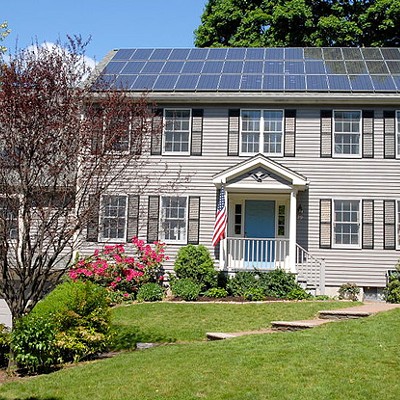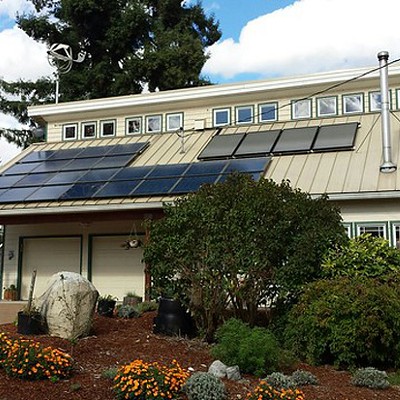A rancher from birth, Stacy Davies came to Eastern Oregon for the wide-open spaces and solitude. Davies, who runs the 200,000-acre plus Roaring Springs Ranch near Burns, said he was essentially driven from his native Utah by oil and gas development on the east side of the state. The boom economy fractured the long-standing farming and ranching community, even as it created lucrative jobs.
Davies, now 43, had no interest in working in the industry, so he put the oil derricks in his rearview mirror and headed west to Harney County, home of Burns and Steens Mountain. Now Davies worries that another kind of energy development could threaten the unspoiled expanses of eastern Oregon, the way the gas and oil industry did Utah.Wind power, a darling of the renewable energy industry, is getting a push back from ranchers like Davies and conservationists. They worry that the rush to harness wind will have long-term negative impacts on some of America’s last unspoiled places. That includes the area around Steens Mountain where impacts to raptors and threatened sage grouse cannot always be fully mitigated.
There’s also a more basic concern. Advocates for places like the Steens, be they ranchers or environmentalists, say the construction of the now ubiquitous wind turbines will forever alter a landscape that derives its allure as much from what it doesn’t have as what it does.
“In my home county in eastern Utah, that economy changed from an agricultural area to an industrial one and it changed everything. The desire to have healthy wild places, clean water and a beautiful viewshed just eroded,” Davies said. “We love the Steens and we bought a lot of land here so we can keep it like it is.”
The issue has been brought to a head in Harney County, thanks to a proposed wind farm project near Steens Mountain, an area that is a year-round draw for hikers, campers, birders and sportsmen.
The proposed project at one time included four wind farms, but has since been scaled back to one site with another in the offing. Still it would entail 40 to 60 turbines, each roughly 300-feet tall with blades as long as 150 feet. These will spike into the sky just outside the Steens Wilderness and surrounding cooperative management area on the privately held Mann Lake Ranch, where owner Hoyt Wilson has inked a lease with the developer.
The wind farm, dubbed the Echanis project after a Basque family that settled the area in the 1800s, already has the seal of approval from county commissioners, and the developer is now awaiting the final approval of a transmission line to connect the farm with the regional power grid.
Opponents say the development flies in the face of the longstanding public commitment to protect Steens Mountain from development. Not only that, but critics say the setup was designed to take advantage of a loophole that requires projects greater than 105 megawatts to submit their applications to the state’s Energy Facility Siting Council. Each wind turbine is slated to produce 104 megawatts.
“It’s not just coincidence that this proposed project is four 104 megawatt projects. They wanted to avoid state jurisdiction in order to minimize the amount of mitigation and the amount of analysis. Projects like this were trying to game the system,” said Brent Fenty, executive director at the Oregon Natural Desert Association which opposes the project.
Columbia Energy President Chris Crowley did not return phone calls seeking comment on this story.
Harney County officials say they don’t have any desire to turn the region into the next Columbia Gorge, where the turbines are now the defining feature of the landscape in many areas. They point out that the proposed wind farm sits outside the Steens management area on private land where there are no restrictions on development such as wind turbines.
The ongoing tug of war over the project is now headed to a federal judge who will decide the fate of the Echanis windfarm and likely any other projects in the surrounding area.
Whatever the outcome, this fight underscores the precarious politics of renewable energy as the industry has grown from a feel-good niche to a deep-pocketed and influential lobby that has wrapped itself in the protective rhetoric of sustainable development and energy independence. Those positions are playing out interestingly in conservative Harney County where officials are quick to tout the projects “green” credentials, a first perhaps in a county where “enviro” is a four, not a six-letter word.
The county’s top elected official, Judge Steve Grasty, for example, said he isn’t sold on global warming, but he believes climate change is happening. Wind farms can help address the issue and help decrease the nation’s dependence on foreign oil, he said.
But Grasty has another, more pressing, concern than CO2 emissions. His constituency is desperate for some kind of positive economic news.
Hard Times in Harney
Harney County has a scant 7,400 souls, but comprises more than 10 percent of Oregon’s entire land area, roughly 10,000 square miles. The unemployment rate hovers near 20 percent, among the highest in the state. The biggest employer in the county is the Safeway supermarket in Burns. The only real blue-collar jobs disappeared with the closing of Monaco Coach several years ago.
It wasn’t always this way.
Burns was once a solid center of rural employment. A Louisiana Pacific sawmill once churned out pine lumber and paychecks, but the sawmill has been shuttered for decades, the victim of changing international markets and a more stringent federal forest policy. Grasty remembers the pre-bust Burns as a place of opportunity and entrepreneurship.
Grasty, who also serves as the chief administrator, opened an auto parts store in the 1980s when Burns was a bustling rural community. He remembers looking at his buddies who worked in the mill with a touch of envy for their healthy paychecks. Things turned quickly with the closing of the mill. Workers who were buying new cars just a few years before were now coming to his parts store to keep their old trucks running just a little longer.
“I’ve watched this place essentially eroding,” said Grasty, who like other Harney County workers prefers a pair of blue jeans around the office to a suit and tie, or even a pair of slacks. “Our population is draining. Our churches are getting so tiny that you don’t need a whole bunch of pews, you just need one or two rows.”
There are other consequences of such economic hardship. Struggling workers mean a spike in social problems. Grasty said spousal abuse rates are higher today; drug use is a bigger problem. The jail is more full now than in the past.
Harney County isn’t looking for a handout, said Grasty. The federal, state and local government already account for 50 percent of the jobs in the region. What Harney County needs, said Grasty, is more private sector employment. When critics dismiss the dozen to 20 permanent jobs that will be created by a single wind farm, Grasty is quick to remind that in Harney County a dozen jobs is the statistical equivalent of several hundred jobs in a larger market.
Randy Fulton knows firsthand how hard it can be to create jobs in an area where there is little to build upon. Fulton’s family ran the garbage collection business in Burns for decades before Fulton sold the company to his employees. The businessman and longtime community volunteer and coach packed his bags and headed for Nevada and retirement. But something drew him back to Burns where he now serves as the Harney County economic development director. It’s Fulton’s job to chase down the few business leads provided by the state. It’s more like working cold case files than a bustling metro homicide unit.
Fulton has been on the job for more than a year and, by his own account, has yet to land a significant employer in Harney County. He’s currently courting a food processor that he hopes will create several dozen full-time jobs. At this point though, it remains just a possibility. With so few solid prospects, Vancouver-based Columbia Energy Partners’ wind farm proposal represents the single largest investment in Harney County since the Monaco coach plant.
The tax revenue alone is worth an average of $700,000 annually to Harney County over the next 15 years, no pocket change in a county with an extremely modest tax base.
While the biggest economic boon is related to the construction rather than operation of the wind farm, both Grasty and Fulton say it’s just the kind of financial shot in the arm that Burns and the area in general needs.
“We need something and it’s not going to be timber,” Fulton said. “Even if they decided to cut trees (on the national forest), we still don’t have a mill.”
Instead, Fulton’s organization has identified renewable energy, including solar, geothermal and wind as part of its economic development blueprint for Harney. While there have been several smaller scale geothermal projects, Columbia Energy Partner's proposal is the first large-scale investment. A single turbine can cost $1 million or more, and the project build-out could create hundreds of good-paying, if temporary, construction jobs in a county where the median household income is less than $40,000, according to the U.S. Census Bureau.
Right Project Wrong Place
Project opponents say they sympathize with Harney’s plight. However, they say job creation is not worth potentially degrading one of Oregon’s truly spectacular places.
In this case, critics say the project’s visual and ecological impacts are too great to ignore.
“It’s pretty obvious that if you have a huge turbine the size of the Statue of Liberty right up against a wilderness area, it’s going to affect the character of a wilderness,” said Matt Little, conservation director for the Bend-based Oregon Natural Desert Association (ONDA).
Little’s organization was largely caught off guard by the wind farm, which was reviewed and approved by Harney County officials with little fanfare. Little said the only public notice of the massive development was provided in the local paper and nearly escaped the notice of ONDA staff, which watchdogs energy development and grazing on the broad expanse of public lands east of Bend.
ONDA has a relatively contentious history in Harney County where cattle ranching is king and federal lands are viewed as an extension of private landholdings.
“There’s a bunch of good people involved with ONDA, but their main goal, and I give them credit, they come right out and say it, is to return all Southeastern Oregon to its pristine state, which means all of us have to go,” Fulton said.
Fenty, whom one of Judge Grasty’s fellow Harney County commissioners once publicly branded a “terrorist,” dismisses Fulton’s characterization of ONDA.
“That’s just bogus. No one has ever said that,” Fenty said.
That kind of misrepresentation simply muddies the discussion about how to balance the need for responsible development and the need to protect existing resources.
“All it does is incite public opinion. We’ve made it clear we want to work with Harney County to find out where this could be done responsibly because there are places it could be,” Fenty said.
He said ONDA commissioned its own wind power study that outlines where some of those places are in Eastern Oregon. Along with other groups, ONDA is now pushing the governor, who recently released a 10-year energy plan, to take a more active role in determining where to cite future renewable projects. Fenty and other conservationists say they are doing that in hopes of avoiding the kind of fight that is occurring in Harney County right now.
Courting Controversy
After failing to negotiate a compromise, ONDA is now looking to the courts for a resolution.
Since the proposed transmission line that will connect to the Harney Electric Cooperative crosses federal lands, including a portion of the Steens cooperative management area, ONDA and other opponents, including the Portland Audubon Society have an opening to challenge that critical portion of the project in federal court. That case is likely to be heard sometime later this year, said Laird Lucas, executive director of Advocates for the West, a Boise-based legal center whose attorneys are arguing the case for ONDA and Portland Audubon.
Winning at the federal level is key, say opponents, because it would block the transmission line that opens the door, not only for Echanis but potentially hundreds more turbines in southeast Oregon.
“This is a high-capacity line. And the gorge is a great case in point. Once you see one development, you tend to see many more. We’re very concerned that not only are we going to see impacts from this project, it’s going to be amplified,” said Bob Sallinger, conservation director for Portland Audubon.
Lucas said both sides are seeking to expedite the trial in order to avoid the plaintiffs seeking an injunction against construction.
Lucas said the legal arguments will focus on the government’s failure to incorporate the best available science when it came time to analyze the project’s impact on sensitive species and habitat. That work was almost entirely completed by consultants working at the behest of the applicant and in some cases wasn’t completed until after the federal government signed off on the project.
However opponents fare before the judge, Lucas said he’s confident the plaintiffs have already won in the court of public opinion.
“We have to recognize, no matter how much we like wind power and renewables, certain wild landscapes are worth protecting,” Lucas said.
Rancher Davies, agrees, at least in part. Davies said he respects his neighbor’s right to the turbines, even if he has concerns about the impact on wildlife and the scenery. But he doesn’t like the idea of the transmission line crossing his land, an incursion for which Davies said he will be only minimally compensated.
The fact that the whole project is propped up by federal tax incentives is the salt in the wound.
“We believe in capitalism and the free market system. If there is a need for power and that power can be developed in a way that makes economic sense, great…But, I guess when they use my money to ruin my viewshed, I’m not really a fan of that,” Davies said.


























